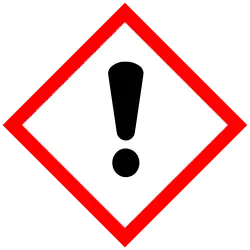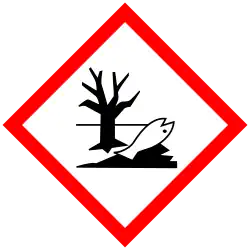Allidochlor
 | |
| Names | |
|---|---|
| IUPAC name
N,N-Diallyl-2-chloroacetamide
| |
| Preferred IUPAC name
2-Chloro-N,N-di(prop-2-en-1-yl)acetamide | |
| Other names
2-Chloro-N,N-di-2-propenylacetamide
| |
| Identifiers | |
3D model (JSmol)
|
|
| ChEBI | |
| ChEMBL | |
| ChemSpider | |
| ECHA InfoCard | 100.002.065 |
| EC Number |
|
| KEGG | |
PubChem CID
|
|
| UNII | |
| UN number | 2996 (RANDOX) |
CompTox Dashboard (EPA)
|
|
| |
| |
| Properties | |
| C8H12ClNO | |
| Molar mass | 173.64 g·mol−1 |
| Appearance | Oily amber coloured liquid[1] |
| Density | 1088 kg/m3[1][2] |
| Melting point | 25 °C (77 °F; 298 K)[1] |
| Boiling point | 74 °C (165 °F; 347 K)[1] |
| 197 g/L[1] | |
| Vapor pressure | 1250 mPa[1] |
| Hazards | |
| GHS labelling:[3][2] | |
 
| |
| Warning | |
| H302, H311, H315, H319, H411 | |
| P264, P270, P273, P280, P301+P312+P330, P302+P352+P312, P337+P313, P361+P364, P391, P501 | |
| Flash point | 186 °C (367 °F; 459 K)[1] |
| Lethal dose or concentration (LD, LC): | |
LD50 (median dose)
|
700 mg/kg (rat, oral) 360 mg/kg (rat, dermal)[2] |
Except where otherwise noted, data are given for materials in their standard state (at 25 °C [77 °F], 100 kPa).
Infobox references
| |
Allidochlor is a herbicide introduced in 1958. It is an obsolete amide herbicide,[4][1] used prёemergently and postemergently.[5]
Allidochlor's HRAC Group is Group 15, Group K3, Group K. (Numeric, Global, Australian)[1]
Application
Allidochlor has been used in Canada, where it was applied at high rates (7 kg/Ha) with much spraywater (500 L/Ha). At the time, 1984, allidochlor was registered for use on onions only in Canada, with leek usage not granted for lack of residue data.[5]
Environmental behaviour
Allidochlor is highly volatile and likely to bioconcentrate.[6] Residue in leeks, treated with up to 3 applications of 7 kg/Ha of allidochlor, was under 100 ppb.[5]
Formulations
Formulations of allidochlor have been marketed as "Randox", "Randox T", "Actox Granular", "Vega-Rand" and "Cdaa 20 G", usually supplied as emulsifiable concentrate.[1][7]
References
- ^ a b c d e f g h i j Lewis, Kathleen A.; Tzilivakis, John; Warner, Douglas J.; Green, Andrew (18 May 2016). "An international database for pesticide risk assessments and management". Human and Ecological Risk Assessment: An International Journal. 22 (4): 1050–1064. Bibcode:2016HERA...22.1050L. doi:10.1080/10807039.2015.1133242. Retrieved 15 August 2025.
- ^ a b c "Pestanal Safety Data Sheet Version 8.4". 17 May 2024. Retrieved 15 August 2025.
- ^ "Substance Information - ECHA". echa.europa.eu. Retrieved 15 August 2025.
- ^ "Kegg Compound: C19043". www.genome.jp. Retrieved 15 August 2025.
- ^ a b c Cessna, Allan (January 1984). "Determination of allidochlor residues in pre- and/or postemergence-treated leeks". Journal of Agricultural and Food Chemistry. 32 (1): 171–173. Bibcode:1984JAFC...32..171C. doi:10.1021/jf00121a040.
- ^ Hertfordshire, University of. "Allidochlor (Ref: CP 6343)". sitem.herts.ac.uk.
- ^ "Allidochlor". pesticideinfo.org. Retrieved 15 August 2025.
External Links
- Allidochlor in the Pesticide Properties DataBase (PPDB)